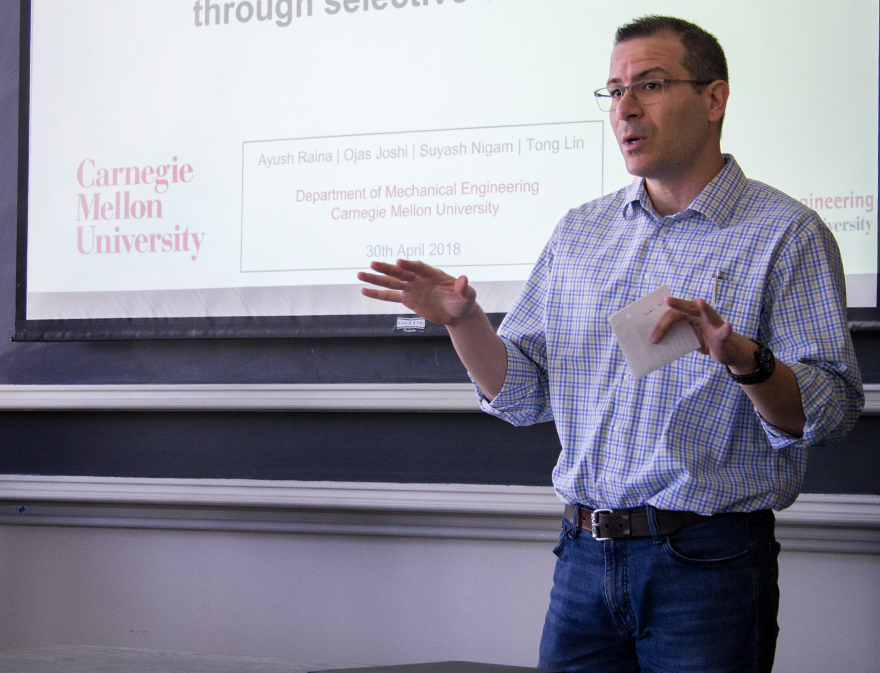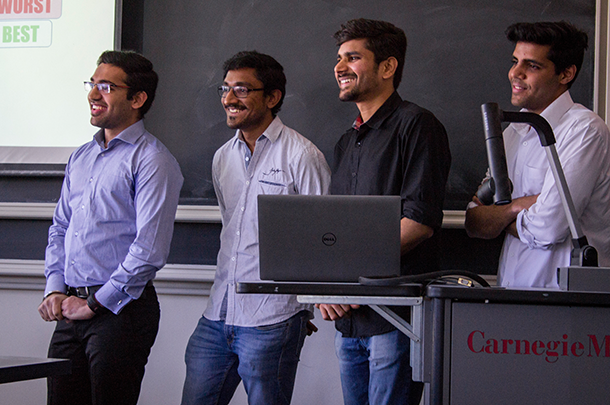Using AI to solve real-world problems
In Levent Burak Kara’s project-based graduate course, students applied their skills in artificial intelligence and machine learning to solve real-world problems outside the classroom.
Traditionally, classrooms are where students learn, but sometimes going outside the classroom helps students develop their skills in fruitful ways. In his new project-based graduate level course, Mechanical Engineering (MechE) Professor Levent Burak Kara led students through independent group projects to solve real-world problems using artificial intelligence and machine learning techniques.
Over the last several years, Kara has seen the number of students in his graduate-level artificial intelligence and machine learning course grow steadily. In that course, graduate students learned fundamental artificial intelligence and machine learning techniques, such as probabilistic learning, pattern recognition, neural networks, clustering, regression, and search to develop skills to solve engineering tasks.
Kara’s new course from the past spring semester, an artificial intelligence and machine learning project course, builds on the principles from the fundamentals course. Students took the techniques they’ve learned and applied them to real-world engineering problems of their interest.

Source: Carnegie Mellon University College of Engineering
Kara introduces a group’s presentation before the class.
“They're tackling interesting problems, which I won't even be able to solve, because it's within their own research field, and they're interested in that,” said Kara. “But we're using machine learning mostly to solve those problems.”
Because the course’s focus was on real-world applications of artificial intelligence and machine learning, it was structured as a project-based course, with the students dividing into small groups of three or four. Every week, the groups met with Kara to discuss their progress, challenges they were facing, and possible solutions.
As artificial intelligence and machine learning continue to grow more and more popular, they are shaping the landscape of research and changing what engineers and scientists can do. Courses like this one allow students to go into the work force with an advantage.
“A lot of the IT companies are interested in machine learning talents because if you understand the principles of machine learning, you can apply them to a wide range of interesting problems,” said Kara. “You can take the foundation, your basic skills, and then apply to a different application with very little overhead.”
Students get to formulate the problem, develop and test multiple approaches, and run rigorous validation studies to justify their claims.
Levent Burak Kara, Professor, Mechanical Engineering, Carnegie Mellon University
For the main learning experiences in his course, Kara said, “Students get to formulate the problem, develop and test multiple approaches, and run rigorous validation studies to justify their claims. This allows students to get a better appreciation for the strengths and weaknesses of different algorithms, while enabling them to come up with interesting variations to the conventional algorithms.”
The student projects covered a wide range of topics. One project researched what constitutes a “good” and a “bad” photograph, and how to use artificial intelligence to compose a “good,” or aesthetically pleasing, photograph. Another group developed a system to automatically create remixed songs from original ones, using existing originals and remixes as their training data.
Ojas Joshi, who graduated this spring with his M.S. in MechE, and his group met at the intersection of image motion deblurring and object detection. For their project, they wanted to develop a system that could deblur a selected part of an image.
“Our project could be subdivided into two parts. One was object detection, and the second was image deblurring,” said Joshi. “We combined those two things together in an ensemble. The image deblurring algorithms deblur the whole image; they don't care about the detection part. So we were mainly focused on improving object detection with image deblurring.”

Source: Carnegie Mellon University College of Engineering
At the close of the semester, each group presented its research and results.
Ph.D. student in MechE Rebecca Tanzer and her group designed their project to predict pollutant concentration at locations without monitors. The group set up a network of 50 sensors dispersed throughout Pittsburgh to measure particles, specifically of PM 2.5, an air pollutant that is a health concern at high concentration levels. The group gathered a large dataset with data collected from the sensors, land use data, and meteorological data and fed it into a random forest model and neural network, two techniques they learned in Kara’s prerequisite course. The algorithms then had outputs of predicted concentrations in a given area.
“You want to be able to know what concentration you're being exposed to in any given spot in Pittsburgh,” said Tanzer. “If you have a map that could be on a website or an app or something, that could tell you how high the pollutant concentration is for where you are, that might impact your decisions about where you go to a park that has higher concentration or lower concentration.”
Joshi and Tanzer appreciated the freedom to work on a project they were interested in while also having Kara’s supervision to guide them through their teams’ independent research. Both hope to continue working on their respective projects, now that the course is finished.
“It was good to learn more about machine learning while applying it to a real problem,” said Tanzer. “It's not just learning for the sake of learning.”
